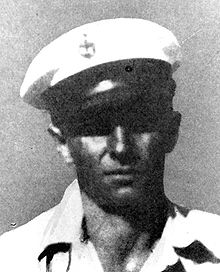Peter Tomich
Peter Tomich Petar Herceg 'Tonić' | |
|---|---|
 Chief Watertender Peter Tomich | |
| Born | June 3, 1893 Prolog, Ljubuški, Bosnia and Herzegovina, Austria-Hungary |
| Died | December 7, 1941 (aged 48) KIA at Pearl Harbor, Hawaii |
| Allegiance | |
| Service/ | |
| Years of service | 1917–1919 (Army) 1919–1941 (Navy) |
| Rank | Chief Watertender (Navy) |
| Unit | USS Litchfield (DD-336) USS Utah (BB-31) |
| Battles/wars | World War I World War II |
| Awards | Medal of Honor |
Petar Herceg Tonić (later anglicized as Peter Tomich; June 3, 1893 – December 7, 1941) was a United States Navy sailor of Bosnian Croat descent who received the United States military's highest award, the Medal of Honor, for his actions in World War II.[1]
Biography
Tomich was an ethnic Croat from Herzegovina born as Petar Herceg (family nickname 'Tonić') in Prolog near Ljubuški, Condominium of Bosnia and Herzegovina. He immigrated to the United States in 1913, and joined the US Army in 1917.[2]
World War I
Tomich served in the US Army during World War I, and enlisting in the US Navy in 1919, where he initially served on the destroyer USS Litchfield (DD-336).[1]
World War II
By 1941, he had become a chief watertender on board the training and target ship USS Utah.[1] On December 7, 1941, while the ship lay in Pearl Harbor, moored off Ford Island, she was torpedoed during Japan's raid on Pearl Harbor.[1] Tomich was on duty in a boiler room. As Utah began to capsize, he remained below, securing the boilers and making certain that other men escaped, and so lost his life.[1] For his "distinguished conduct and extraordinary courage" at that time, he posthumously received the Medal of Honor.[1] His Medal of Honor was on display at the Navy's Senior Enlisted Academy (Tomich Hall).[1] Later, the decoration was presented to Tomich's family on the aircraft carrier USS Enterprise in the southern Adriatic city of Split in Croatia, on 18 May 2006, sixty-four years after US President Franklin D. Roosevelt awarded it to him.[3]
Medal of Honor citation
For distinguished conduct in the line of his profession, and extraordinary courage and disregard of his own safety, during the attack on the Fleet in Pearl Harbor by the Japanese forces on 7 December 1941. Although realizing that the ship was capsizing, as a result of enemy bombing and torpedoing, Tomich remained at his post in the engineering plant of the U.S.S. Utah, until he saw that all boilers were secured and all fireroom personnel had left their stations, and by so doing lost his own life."[4]
Legacy
- The destroyer escort USS Tomich (DE-242), 1943–1974, was named in honor of Chief Watertender Tomich.[5]
- The United States Navy Senior Enlisted Academy in Newport, RI is named Tomich Hall in honor of Chief Watertender Tomich.[6]
- The Steam Propulsion Training Facility at Service School Command Great Lakes is named in honor of Chief Watertender Tomich.[7]
- The U.S. Citizenship and Immigration Services Headquarters Conference Room in Washington, D.C., is named the Peter Tomich Conference Center.[6]
See also
References
- ^ a b c d e f g Hagan (2004), pp. 435–36.
- ^ "Navy Chief Watertender Peter Tomich - World War II | USCIS". Uscis.gov. Retrieved 2015-11-24.
- ^ "President Mesić decorated the US Admiral Lunney with the Order of Trefoil". Croatia.org. Retrieved 2015-11-24.
- ^ "Medal of Honor recipients". United States Army Center of Military History. December 3, 2010. Retrieved December 6, 2010.
- ^ [1] Archived copy at the Library of Congress (October 7, 2012).
- ^ a b "Navy Chief Watertender Peter Tomich - World War II | USCIS". Uscis.gov. Retrieved 2015-11-24.
- ^ "The Navy On Our Shore".
Bibliography
- Hagan, John (2004). Chief Petty Officer's Guide. Annapolis: Naval Institute Press. ISBN 1-59114-459-0.
- 1893 births
- 1941 deaths
- People from Ljubuški
- Croats of Bosnia and Herzegovina
- American people of Croatian descent
- American people of Bosnia and Herzegovina descent
- Austro-Hungarian emigrants to the United States
- United States Army soldiers
- United States Navy sailors
- American military personnel of World War I
- American military personnel killed in World War II
- United States Navy Medal of Honor recipients
- Foreign-born Medal of Honor recipients
- Attack on Pearl Harbor
- World War II recipients of the Medal of Honor
